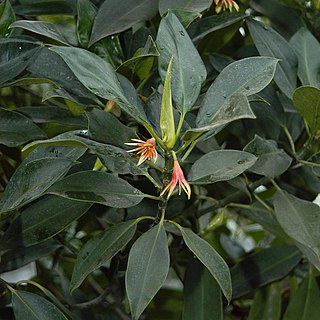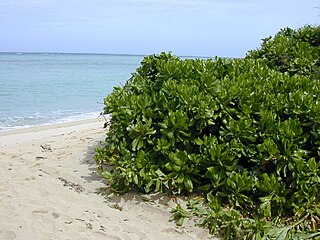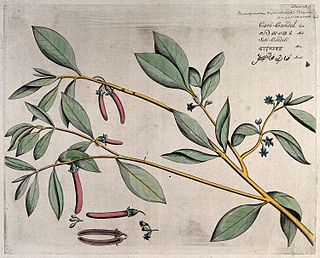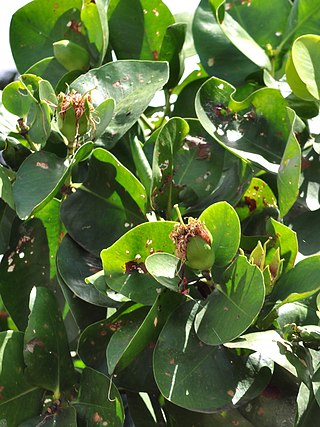
The coconut tree is a member of the palm tree family (Arecaceae) and the only living species of the genus Cocos. The term "coconut" can refer to the whole coconut palm, the seed, or the fruit, which botanically is a drupe, not a nut. The name comes from the old Portuguese word coco, meaning "head" or "skull", after the three indentations on the coconut shell that resemble facial features. They are ubiquitous in coastal tropical regions and are a cultural icon of the tropics.

Lodoicea, commonly known as the sea coconut, coco de mer, or double coconut, is a monotypic genus in the palm family. The sole species, Lodoicea maldivica, is endemic to the islands of Praslin and Curieuse in the Seychelles. It has the largest seed in the plant kingdom. It was also formerly found on the small islets of St Pierre, Chauve-Souris, and Ile Ronde, all located near Praslin, but had become extinct there for a time until recently reintroduced.

Yala (යාල) National Park is the most visited and second largest national park in Sri Lanka, bordering the Indian Ocean. The park consists of five blocks, three of which are now open to the public. There are also two adjoining parks, Kumana National Park or 'Yala East' and Lunugamvehera National Park. The blocks have individual names, such as Palatupana. It is situated in the southeastern region of the country, in the Southern Province and Uva Province. The park covers 979 square kilometres (378 sq mi) and is located about 300 kilometres (190 mi) from Colombo. Yala was designated as a wildlife sanctuary in 1900, along with Wilpattu, designated in 1938, as the first two designated national parks in Sri Lanka. The park is best known for its variety of wildlife and is important conservation of Sri Lankan elephants, Sri Lankan leopards and aquatic birds.

Aerial roots are roots above the ground. They are almost always adventitious. They are found in diverse plant species, including epiphytes such as orchids (Orchidaceae), tropical coastal swamp trees such as mangroves, banyan figs, the warm-temperate rainforest rata, and pohutukawa trees of New Zealand. Vines such as common ivy and poison ivy also have aerial roots.

Pandanus is a genus of monocots with some 578 accepted species. They are palm-like, dioecious trees and shrubs native to the Old World tropics and subtropics. The greatest number of species are found in Madagascar and Malaysia. Common names include pandan, screw palm and screw pine. They are classified in the order Pandanales, family Pandanaceae.

Sri Lankan cuisine is known for its particular combinations of herbs, spices, fish, vegetables, rices, and fruits. The cuisine is highly centered around many varieties of rice, as well as coconut which is a ubiquitous plant throughout the country. Seafood also plays a significant role in the cuisine, be it fresh fish or preserved fish. As a country that was a hub in the historic oceanic silk road, contact with foreign traders brought new food items and cultural influences in addition to the local traditions of the country's ethnic groups, all of which have helped shape Sri Lankan cuisine. Influences from Indian, Indonesian and Dutch cuisines are most evident with Sri Lankan cuisine sharing close ties to other neighbouring South and Southeast Asian cuisines.

Aegle marmelos, commonly known as bael, also Bengal quince, golden apple, Japanese bitter orange, stone apple or wood apple, is a species of tree native to the Indian subcontinent and Southeast Asia. It is present in India, Pakistan, Bangladesh, Sri Lanka, and Nepal as a naturalized species. The tree is considered to be sacred by Hindus and Buddhists.

Annona glabra is a tropical fruit tree in the family Annonaceae, in the same genus as the soursop and cherimoya. Common names include pond apple, alligator apple, swamp apple, corkwood, bobwood, and monkey apple. The tree is native to Florida in the United States, the Caribbean, Central and South America, and West Africa. It is common in the Everglades. The A. glabra tree is considered an invasive species in Sri Lanka and Australia. It grows in swamps, is tolerant of saltwater, and cannot grow in dry soil.
Maldivian mythology or Maldivian folklore is the body of myths, tales and anecdotes belonging to the oral tradition of Maldivians. Even though some of the Maldivian myths were already mentioned briefly by British commissioner in Ceylon HCP Bell towards the end of the 19th century, their study and publication were carried out only quite recently by Spanish writer and artist Xavier Romero-Frias, at a time when that ancestral worldview was quickly disappearing.

Heritiera littoralis, commonly known as the looking-glass mangrove or tulip mangrove, is a mangrove tree in the family Malvaceae native to coastal areas of eastern Africa, Asia, Melanesia and northern Australia. The common name refers to the silvery appearance of the underside of the leaves, resembling a mirror to some degree. The strong timber has uses in marine applications and elsewhere.

The Sulawesi flying fox or Sulawesi fruit bat is a species of megabat endemic to Indonesia. It is classified as "Vulnerable" by the IUCN due to unsustainable levels of hunting.

Bruguiera gymnorhiza, the large-leafed orange mangrove or oriental mangrove,) is a mangrove tree that grows usually to 7–20 metres (23–66 ft) high, but sometimes up to 35m, that belongs to the family Rhizophoraceae. It is found on the seaward side of mangrove swamps, often in the company of Rhizophora. It grows from the Western Pacific across Indian Ocean coasts to Cape Province, South Africa.

Scaevola taccada, also known as beach cabbage, sea lettuce, or beach naupaka, is a flowering plant in the family Goodeniaceae found in mangrove swamps and rocky or sandy coastal locations in the tropical areas of the Indo-Pacific. It is a common beach shrub throughout the Arabian Sea, the tropical Indian Ocean and the tropical islands of the Pacific Ocean.

Bruguiera cylindrica is a mangrove in the family Rhizophoraceae. It grows in mangrove swamps in tropical Asia.

Artocarpus camansi, the breadnut, is a species of medium-sized tree in the family Moraceae. It is native to New Guinea, the Maluku Islands, and the Philippines. It is the wild ancestor of the breadfruit (Artocarpus altilis) and is also sometimes known as the seeded breadfruit, to distinguish it from its mostly seedless descendant. Breadnut fruits are edible when cooked. The large seeds can also be roasted and eaten.

Ceriops tagal, commonly known as spurred mangrove or Indian mangrove, is a mangrove tree species in the family Rhizophoraceae. It is a protected tree in South Africa. The specific epithet tagal is a plant name from the Tagalog language.

Lumnitzera racemosa, commonly known as the white-flowered black mangrove, is a species of mangrove in the family Combretaceae. It is found on the eastern coast of Africa and other places in the western Indo-Pacific region. It has one accepted variety from the noniminate species which is Lumnitzera racemosa var. lutea (Gaudich.) Exell.

Sonneratia alba is a mangrove tree in the family Lythraceae. The specific epithet alba is from the Latin meaning "white", referring to the flowers.

Sonneratia ovata is a mangrove tree in the family Lythraceae. The specific epithet ovata is from the Latin meaning "oval", referring to the shape of the leaf.

The Maldives–Lakshadweep–Chagos Archipelago tropical moist forests is a tropical moist broadleaf forest ecoregion in South Asia. It spans a chain of coralline islands in the Indian Ocean, including Lakshadweep, a union territory of India; the Maldives, an independent country; and the British Indian Ocean Territory, an overseas territory of the United Kingdom.






















